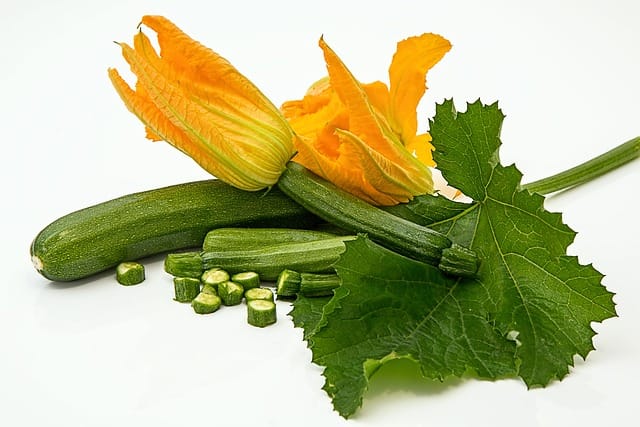How to grow Courgettes
Courgettes, also known as zucchini, are a versatile vegetable that can be grown in many regions

In this article:
- Introduction
- Choosing the right variety
- Preparing the soil
- Starting from seeds
- Transplanting seedlings
- Trellising or staking
- Watering and fertilizing
- Managing pests and diseases
- Pruning and training
- Harvesting courgettes
- Storing and preserving
- Common courgette problems and solutions
- Frequently asked questions
- Conclusion
Introduction
Courgettes, also known as zucchini, are a versatile vegetable that can be grown in many regions. They are easy to care for and provide a bountiful harvest if grown under the right conditions. In this article, we will guide you through the process of growing courgettes from choosing the right variety to harvesting and preserving the crop.
Choosing the right variety
Before starting your courgette garden, it is important to choose the right variety that suits your region and preferences. Look for disease-resistant varieties that are known to perform well in your area. Some popular courgette varieties include Black Beauty, Golden Dawn, and Cocozelle.
Preparing the soil
Courgettes thrive in well-drained and fertile soil. Start by clearing the area of any weeds or debris. Loosen the soil with a garden fork or tiller and incorporate organic matter such as compost or well-rotted manure to improve fertility. Aim for a pH level of 6.0 to 7.0 for optimal growth.
Starting from seeds
One of the most economical ways to grow courgettes is from seeds. Start by soaking the seeds in water for 24 hours to promote germination. Plant the seeds in small pots or seed trays filled with seed-starting mix. Keep the soil consistently moist and maintain a temperature of around 20-25°C. Seedlings should emerge within 7-10 days.
Transplanting seedlings
Once the seedlings have developed a few sets of true leaves, they are ready to be transplanted into the garden. Choose a sunny location with adequate spacing between plants. Dig a hole slightly larger than the root ball of each seedling and gently place it in the hole. Water thoroughly after transplanting to settle the soil.
Trellising or staking
To save space and promote airflow, courgette plants can be trellised or staked. This prevents the fruit from touching the ground, reducing the risk of rot and disease. Install a trellis or stake near each plant and gently tie the main stem to provide support as the plant grows.
Watering and fertilizing
Keep the soil consistently moist but not waterlogged. Courgettes require regular watering, especially during hot and dry periods. Mulching around the plants can help retain moisture and suppress weeds. Fertilize the plants every two weeks with a balanced vegetable fertilizer to ensure healthy growth.
Managing pests and diseases
Common pests that can affect courgette plants include aphids, slugs, and squash bugs. Regularly inspect your plants for signs of infestation and take appropriate measures such as handpicking or using organic insecticides. To prevent diseases such as powdery mildew, avoid overhead watering and maintain adequate spacing between plants to promote airflow.
Pruning and training
To encourage better plant development and fruit production, courgettes can be pruned and trained. Pinch off the lateral shoots that emerge from leaf axils to direct the plant's energy towards fruiting. Training the main stem to grow vertically can also help optimize space and increase yields.
Harvesting courgettes
Courgettes should be harvested when they reach a length of around 15-20 centimeters. Use a sharp knife or shears to cut the fruit from the plant, taking care not to damage the stem or neighboring fruits. Regular harvesting will encourage continuous production throughout the growing season.
Storing and preserving
Courgettes are best consumed fresh, but they can also be stored in the refrigerator for up to a week. To preserve courgettes for longer periods, they can be blanched and frozen. Another popular preservation method is pickling, which allows you to enjoy courgettes all year round.
Common courgette problems and solutions
Some common problems that you may encounter when growing courgettes include blossom end rot, poor fruit set, and powdery mildew. These issues are often caused by nutrient deficiencies, improper watering, or environmental factors. Proper soil preparation, regular inspection, and timely intervention can help mitigate these problems.
Frequently asked questions
Q: How long does it take for courgette seeds to germinate?
A: Courgette seeds typically germinate within 7-10 days when provided with proper conditions.
Q: Can I save courgette seeds for the next season?
A: Yes, you can save courgette seeds for future plantings. Make sure to fully mature the fruit before harvesting the seeds and store them in a cool, dry place.
Conclusion
Courgettes are a rewarding vegetable to grow in your garden. By following the steps outlined in this article, you can enjoy a bountiful harvest of fresh and delicious courgettes. Remember to choose the right variety, prepare the soil adequately, provide proper care, and address any issues promptly. Happy gardening!
